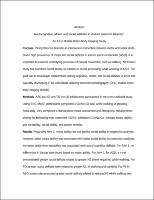Please use this identifier to cite or link to this item:
https://hdl.handle.net/20.500.12202/9239| Title: | Neurocognitive, motor, and social abilities in autism spectrum disorder: An EEG mobile brain-body imaging study |
| Authors: | Weinberger, Andrea H. De Sanctis, Pierfilippo Lee, Christine J. Molholm, Sophie Zemon, Vance Cruz, Lisa |
| Keywords: | Psychology neurosciences |
| Issue Date: | Jun-2023 |
| Publisher: | Yeshiva University |
| Citation: | Cruz, L. (2023, June). Neurocognitive, motor, and social abilities in autism spectrum disorder: An EEG mobile brain-body imaging study (Publication No. 30572534) [Doctoral dissertation, Yeshiva University]. PDTG |
| Series/Report no.: | Ferkauf Doctoral Dissertations;Publication No. 30572534 |
| Abstract: | Purpose. Rising theories describe an interwoven connection between motor and social skills. Given high prevalence of motor and social deficits in autism spectrum disorder (ASD), it is important to examine underlying processes of natural movement, such as walking. No known study has examined social ability in relation to neural processing while walking in ASD. The goal was to investigate relationships among cognitive, motor, and social abilities in ASD and typically developing (TD) individuals utilizing electroencephalography (EEG) mobile brain-body imaging (MoBI). Methods. ASD (n=20) and TD (n=18) adolescents participated in the cross-sectional study. Using EEG-MoBI, participants completed a Go/No-Go task while walking or standing. Separately, they completed a standardized motor assessment and Stroop test. Relationships among the following were examined: N2/P3, inhibition (Go/No-Go, Stroop), motor ability, gait variability, social ability, and autism severity. ¶ Results. Regarding Aim 1, motor ability did not predict social ability in regression analyses; however, better motor ability was associated with better social ability in correlation analyses. Increased stride time variability was associated with social cognitive deficits. For Aim 2, no differences in Stroop were found based on motor ability. For Aim 3, for ASD, a trend demonstrated greater social deficits related to greater N2 (more negative) while walking. For TD, greater social deficits were related to greater N2, in walking and standing. For P3 in ASD, a trend demonstrated greater social deficits related to reduced P3 while walking and standing; for TD, no links were found. TD exhibited greater N2/P3 in standing versus walking; ASD did not. Increased P3 while standing was related to lower autism severity. For Exploratory Aim 1, a trend demonstrated increased social deficits associated with worse manual dexterity in ASD; in TD the opposite was seen. Better manual dexterity was related to lower autism severity. Better balance was related to better social ability. For Exploratory Aim 2, weakened P3 while standing, not walking, was related to greater autism severity. N2 was not related to autism severity. Conclusions. Findings generally supported the idea of a connection between social and motor skills. Increased stride time variability, and poorer balance and manual dexterity were related to greater social deficits. Poorer manual dexterity and weakened P3 were related to greater autism severity. TD, but not ASD, exhibited greater N2/P3 while standing than walking, suggesting differential neural processing. There are implications for screening, intervention, and education |
| Description: | Doctoral dissertation, PhD / Open Access |
| URI: | https://hdl.handle.net/20.500.12202/9239 |
| Appears in Collections: | Ferkauf Graduate School of Psychology: Doctoral Dissertations |
Files in This Item:
| File | Description | Size | Format | |
|---|---|---|---|---|
| Lisa Cruz Dissertation June 2023 OA.pdf | 1.15 MB | Adobe PDF |  View/Open |
This item is licensed under a Creative Commons License

